After a brutal January and February in Edmonton, Sue and I were ready for a Winterbuster trip to Mexico. Our first destination was the Town of San Miguel d’Allenda, famous for its architecture and long term destination of artists and expats escaping northern winters. Of course we also wanted to see Mexico City as well for its renowned festivals and museums. We invited our friends Ted and Joanne Koopmans to come along and they added two other destinations.
Our first stop was to visit a friend of Ted and Joanne’s – Gerardo Debbink a former dairy farmer from Leduc Alberta. Gerardo left the farm to visit and learn about community development in Mexico in 1988 and he hasn’t left. In 1992, he spearheaded and accompanied two shipments of heifer dairy cows, donated by Alberta members of the Christian Farmers Federation. He tells an epic story of getting the cows through quarantines and customs with numerous adventures along the way. The cows were distributed and he worked with the farmers for a number of years focussing first on animal welfare and then later on other social and community issues. In the 1994 he moved to Mexico permanently with his family and bought a piece of land on a hill overlooking the city of Cuernavaca, about an hour south of Mexico City.
In 2001 Gerardo founded Quest Mexico a experiential learning centre with programs focussed on “social justice and peace, and may include matters of gender, race, class, sexuality, economics, and ecology”. His participants are usually college students or church groups who come from 2-6 weeks to learn and participate in Mexican life. Gerardo has built a number of buildings on the site and can house up to 25 participants. When we visited Quest, there were no other visitors that week, so we had Gerardo as tour guide and companion for three days. Gerardo shared some his lesson and slide content and we noticed the strong ‘liberation theology” theme that inspires the general community development program.

On our first day in Mexico we began with breakfast at the community centre/kindergarten that hosts a low cost breakfast program run by a rotating group of local mothers. The community centre is an important focus for residents of a mak do-slum that sprung up to house earth quake survivors on land formally used by the Railroad. When the railroad was first privatized (a NAFTA requirement) and then shut down, the land housing the main Cuernavaca Station and even some of the railroad cars were occupied and gradually a community formed. Makeshift electricity and water followed, but the residents are in constant worry that they may be evicted from their houses. We talked to one young mother who told us of her husband having to work evenings and Saturdays to supplement their income so they could send their three kids on a school trip to to a Safari Camp. This day adventure was to cost them more than a week’s income for both parents.
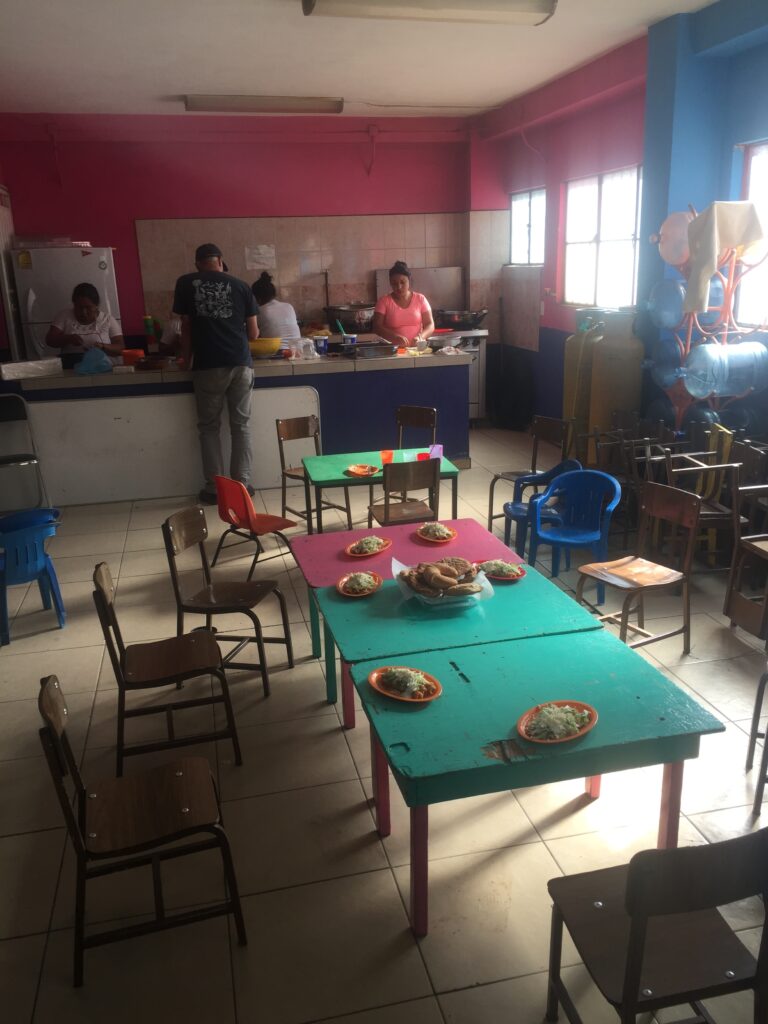
After breakfast at the community centre, and a visit to a kindergarten class, Geraldo took us to visit a family who lived in one of the old rail cars. The extended family (3 generations) have added a fridge , TV and even a WIFI router to the rail car, built a bedroom in the backyard, and a few tables for a restaurant in the front. The family earns a living buying food in the Market and selling tortillas and other foods in a restaurant that runs every evening. They were hospitable and were willing to answer all our questions about life at the “station”. The matriarch of the family had been hit by a vehicle (which didn’t stop) and so was able to talk about the recent challenges of getting and paying for health services for an injured leg.
We next walked through the central market which was a huge set of buildings with hundreds of booths selling everything from produce, to shovels and underwear and everything in between. One of the exercises for the Quest students is to take the bus to the market and buy a days provisions on funds available to most low income Mexicans. Fortunately with Geraldo’s assistance we were able to buy a few groceries and other items and had a good time. We next walked through the central square, filled our cell phone sim cards and enjoyed a low cost lunch. By then it was two o’clock, so Gerardo headed us to an outdoor bar overlooking the square in time for two for one beers! We returned to Quest facilities for a jump in Gerardo’s simple but refreshing rooftop swimming pool and a chance for him to tell us about the Narcos that plagued Chernavaca but fortunately had had little direct impact on Quest and ourselves!

The next day We set off for a visit to Chontalcoatlan – a very small town 90 minutes west of Cervnevaca. Gerardo has been visiting and working in this community for many years and has made many friends. The town is isolated by a 15 mile road (now paved, but not in great shape) from a major highway. The 200 or so residents of the community seem to subsist on gardening and manufacture of handicrafts to be sold in the markets of Ceurnavaca. Our first stop was to visit a family in a very small house off the main road. The house had a bamboo frame, sheet metal roof and sides made up of bamboo sticks, leaving numerous gaps for insects. The yard hosted a tethered cow, a few chickens and more kids from the extended families who occupied this yard. The owners shared the house (and one family bed) with their three kids, and a pet rabbit. The house boasted a refrigerator and a TV and the lady of the house served us tortillas made on the smokey wood fire in the corner of the hut. We were able to ask lots of questions about life in the village. Much of the women’s and children’s lives focussed on trips to the village wells. There were three of these wells that were holes dug sideways in to the hill side, allowing women and kids to walk down steps carved onto the side. One could gauge the amount of water left in the well, by the number of steps that were exposed. It was dry season and so there was very little water left in the well we visited and worries that they would soon have to begin taking water from the last well that was maybe 500 yards UPHILL from the centre of town.
We had a second visit with a young mother, her partner off selling crafts in the City. We asked about school. Most of the younger kids went to elementary school. There was also a high school in the town, but it was unclear if it actually operated because the students didn’t go or the teacher didn’t arrive. In any case, when I asked if anyone from the town had become a teacher or a nurse and returned, the answer was that it hadn’t happened before and was likely too expensive to plan for. We also heard plans for the big wedding celebrations coming up in the village. 25 couples were to be married on the same day- both the priest and the local registrar had an annual sale on marriage services and licenses and the town was taking advantage of the deal!
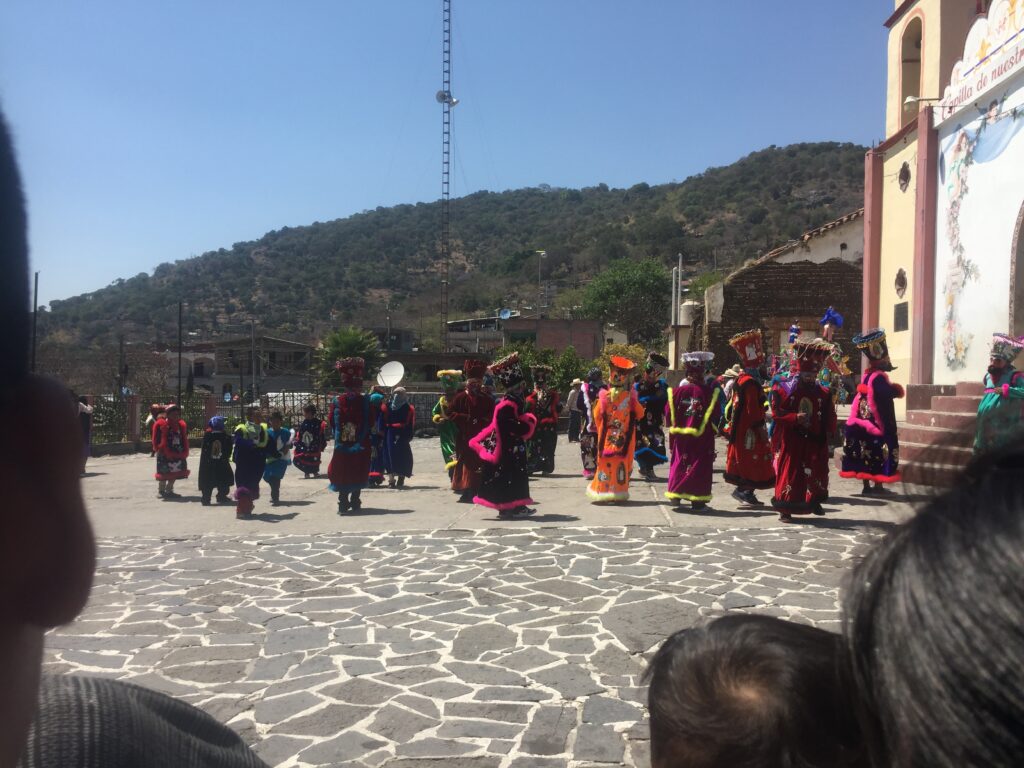
As we exited our final visit, we hard the loud retort of fire crackers and were told that a fiesta had begun in the church yard. I thought it was a bit strange for a party to happen during the middle of Lent and in the churchyard – but so it goes. A band consisting of a couple of trumpets, drums and a tuba were making music for around 15 masked dancers who seemed to be able to dance for a very long time in full costume under the blazing sun. We never really understood what the fiesta was about, but enjoyed the scene. We then drove to the famous ‘silver city” of Taxco. The contrast between the village of Chontalcoatlan and this metropolis was immense. Taxco has been the site of silver and gild mines since colonial times, leaving wealth and a stunning cathedral the insides of which were decorated in silver and gold-leafed images. As we road a bus through town I couldn’t help but feel more comfortable seeing familiar banks and stores and shoppers rather than the dusty village we had just left. We enjoyed a tour of the Cathedral and the hundreds of silver jewelry shops that surround the central square and then enjoyed a fine lunch on a roof-top restaurant overlooking the square. At this quite fancy restaurant we paid practices that would not be unfamiliar in Canada- a contrast from the restaurants at which locals (and often ourselves) ate at which prices were less than half of comparable costs in Canada. After a final day lounging about checking out Gerardo’s educational resources, we prepared to move on, feeling inspired and grateful for the chance to stay for a few days at Quest, learning from Gerardo and his widespread community.
San Miguel d’Allende.


We left the next morning on the bus – about 6 hours north to San Miguel d’Allende. The intercity buses that we rode on in Mexico were quite upscale – even compared to Canadian standards. They featured reserved seats, free snacks as you entered, TVs and huge reclining seats. We had a quick bus change in Mexico City and 4 hours later arrived in San Miguel. San Miguel has been a refuge for artists, expats and tourists since the 1950’s. It is a beautiful town made prosperous from the 17th century by both mines and fertile lands for farming. Also being higher in the hills, the weather and the views are stunning. Our AirBnB ($360 Can for 5 nights) was quite upscale featuring a large living room and deck with a view to the central basilica. We spent the first day walking through the town centre and checked out the community cultural centre, that is located in a large former convent. As we walked into the main courtyard, we saw (and heard) musicians warming up and realized we were just in time to grab chairs in the shade for a symphony concert by the San Miguel Youth orchestra. The performers were all 20-30 years old and we thought very entertaining as they romped through classics by Mozart, Bach and Hayden. As we exited the community at the end of the concert we bumped into the start of a parade of bad bands, blaring speakers and hundreds of costumed characters in all sorts of monster type costumes. They were heading to the Fair grounds near our AirB&B. After all this excitement we had to head for a pub and being St Patrick’s Day, it had to be Irish. Fortunately, Kelly’s Irish pub was only a few blocks away and Mr Google guided us there.
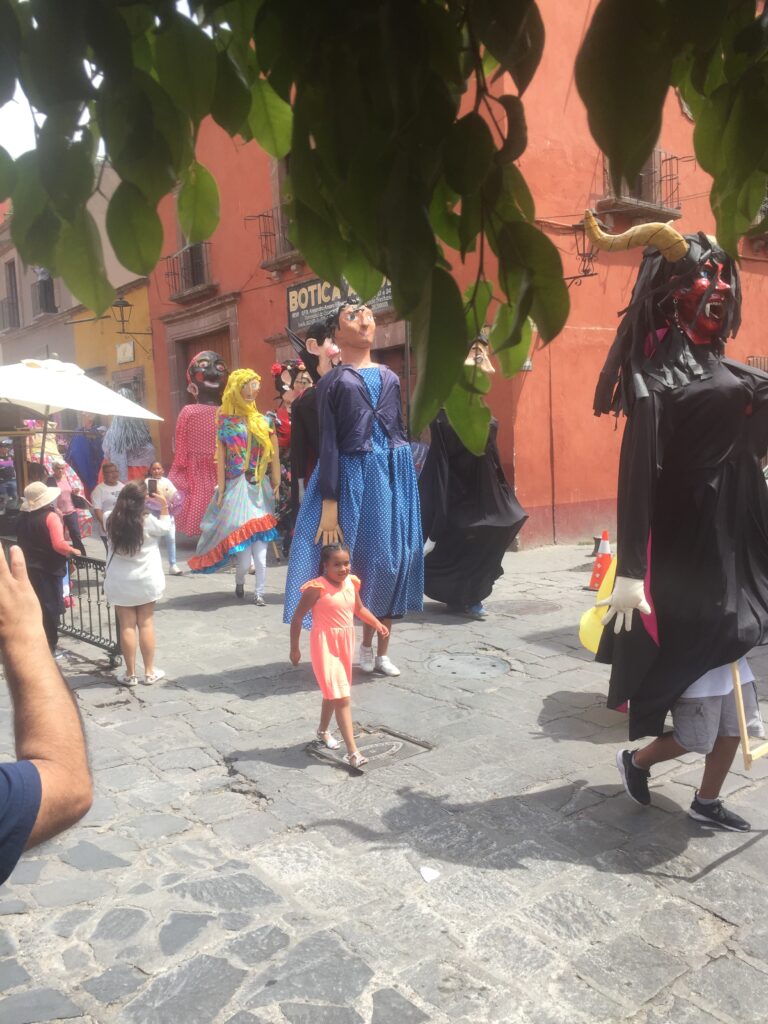
The second day we visited the Escondido hot springs about 8 K north of the town. This open air complex had about 8 swimming pools of various sizes and temperatures and numerous natural pools full of turtles and carp. We wandered through the grounds jumping into most of the pools and ended the day with a fine meal on the terrace overlooking the grounds. We had been using Uber (with good results) but decided to try the Taxi home – cost us 4 times what we had paid Uber man to get there. Live and learn to negotiate a price before hoping in a taxi.
Our final day in St Miguel we toured the main square and churches once again and ended the day on a roof-top restaurant enjoying the sunset and the central square. In line with the tourist nature of the town, we enjoyed a 15 piece Mariachi band in the square as we left.
To the Pyramids at Teotihuacan
For our 3rd stop we planned to head to the famous Teotihuacan ruins north of Mexico City. We took an Uber for the 4 hour drive on toll roads ($250 C.) which worked out nicely – after we rejected the 1st car as too small for 4 plus luggage. We booked a hotel that supposedly was right across the road from the pyramids and sure enough arrived around 2:00 PM. On checking in the clerk asked if we were here for the ceremonies, we relied what ceremonies? Then it dawned on us that it was March 20 and the equinox was to be celebrated the next day. We headed through town of St Martin –walking along the boarder fence to the ruins to arrive at the Gruta restaurant. The restaurant has been operating since 1906 in a deep cave, open in spots to daylight. Great Mexican food and usual Canadian style prices.
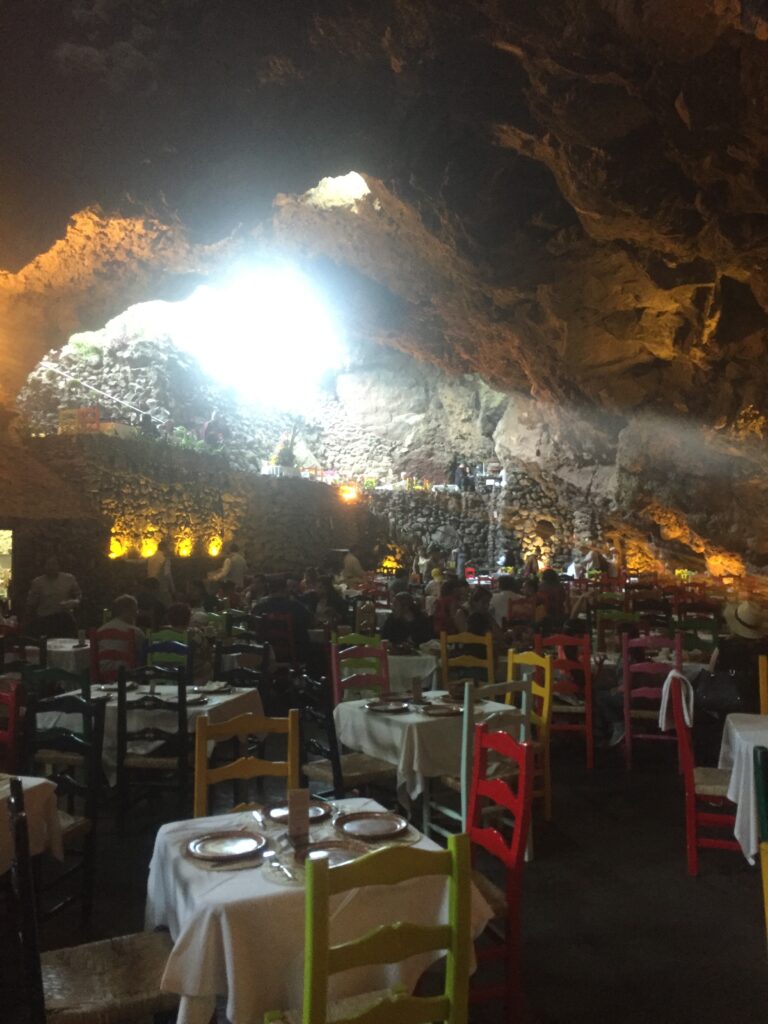

The next morning we headed out to explore the complex at Teotihuacan. It took a 3 km walk to get to the entrance, but we arrived to be near the Pyramid of the Moon, and proceeded to climb up as far as permitted. From the Pyramid of the Moon one could look down the Avenue of Dead, flanked by lower buildings and small pyramids and see the massive Pyramid of the Sun, with hundreds of people climbing and descending from the sumit. As we strolled along the Avenue, avoiding the handicraft salesforce, we heard drumming coming from the plaza fronting the Pyramid of the Sun. We emerged into the plaza to find about 100 dancers, many with feathered headgear dancing to drum beats and smokey snugs. At one point the dancers worked into a spiral round dance, like many I’ve seen here in Alberta.
We then joined the long line up of mostly white clad, Mexican visitors to climb the Pyramid of the Sun. This is the 3rd largest pyramid in the world and the largest in the western hemisphere. Its origins are a bit obscure, Teotihuacin was named by the Aztecs meaning “place that the gods built”, since even in Aztec time, the site was very old and sacred – but abandoned. It took about 45 minutes to ascend to the top of the pyramid – owing mostly to the slow moving crowd. When we finally arrived at the summit, we noticed most people with upraised hands towards the sun. We then heard a conch sound from below, followed by cheering and clapping around us. We had a arrived at the top, at exactly 12:00 noon. Thus celebrating the equinox in style, despite our total lack of planning. The following day we toured the museum at the site and took another Uber ride to Mexico City.
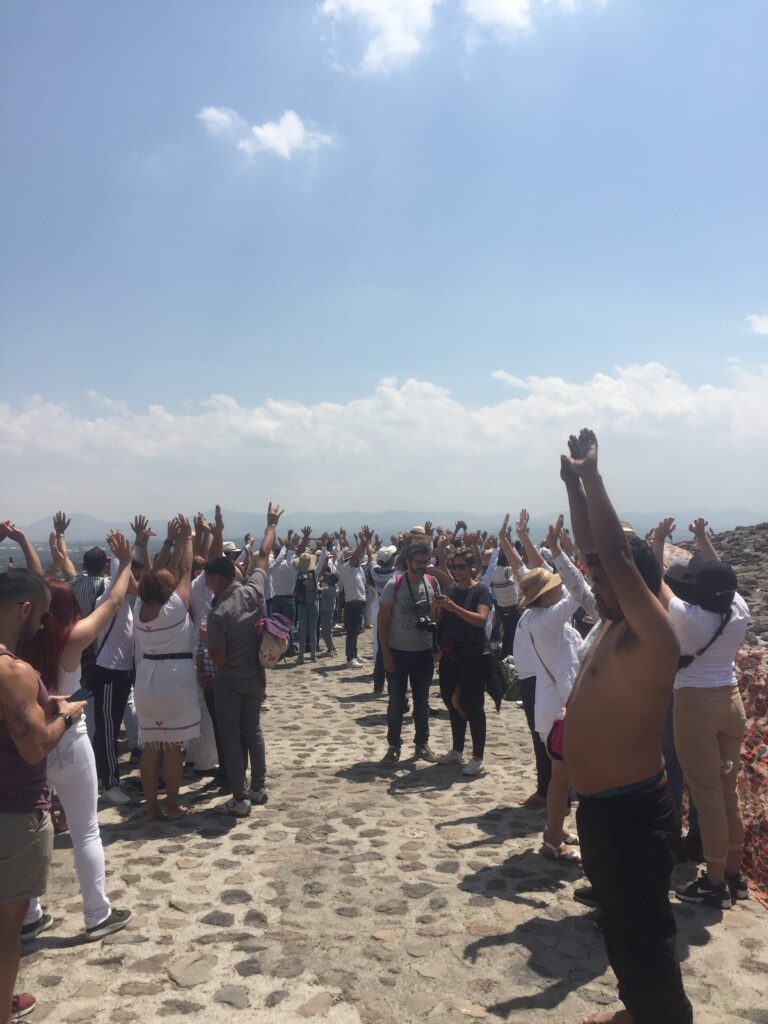
Mexico City
Our final stop was 4 days in Mexico City. The City is huge metropolis (nearly 9 million) and we certainly didn’t do more than visit the major tourist sites. Our AirBnB was much more modest than our flat in St Miguel. However, it was adequate and walking distance to the Historic Centre. We did the usual visits to the Cathedral, main square, president’s palace, Diego Rivera’s murals and the National Anthropological Museum. We were also fortunate to arrive the night before an annual spring festival, at which 16 stages in the central area were scheduled for a wide variety (from jazz, to ‘beats’ to classical) of entertainment on the Saturday night. We also visited the Blue House (now museum) home of Frida Kahlo and her husband Diego Rivera. Frida’s story of overcoming a life of physical pain and her ability to portray a love of life through the pain is an inspiration.
The biggest disappointment of the whole trip occurred on the Mexico City subway, when my wallet was pick-pocketed. I checked the wallet, in a front pocket before entering the subway. On the 2nd train, we squeezed into the entrance, but the other passengers, refused to move down the aisle. I was afraid Susan might not get on the train, so pushed my way through these ‘gentlemen’ to vacant spaces away from the door. In the process of squeezing through, this professional gang lifted my wallet. I didn’t notice the loss until we were leaving the station. 20 minutes later, I had both credit cards cancelled (thank heavens for cell phone and Mexican SIM cards), but there had been multiple purchases and two attempts at cash withdrawals from both credit cards. I lost about $80 cash but received assurances that the purchases would be covered by the banks. But I still have to confront getting and registering new cards and purchasing (and using) a wallet with a security strap/chain. Live and learn.
Summary
We had a great trip, learned lots, enjoyed the company of our friends Ted and Joanne, made new friends, ate and drank good Mexican fare. Our total costs were around $1500/couple for two weeks, plus close to $1,000/couple for airfare. We figure we got our money’s worth.

Such beautiful photos! I particularly admire the one of the street in San Miguel d’Allende. And the serendipity of being on that pyramid at the equinox! I bet the Blue House was quite an experience as well. Glad you had such a great trip & glad to have you both back 😉